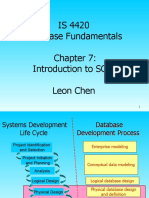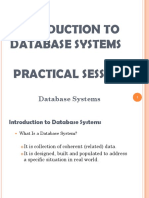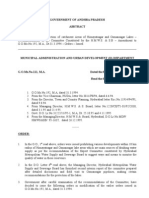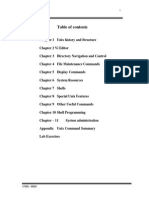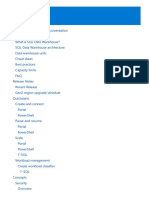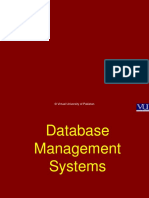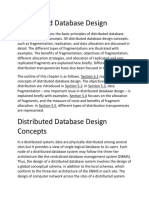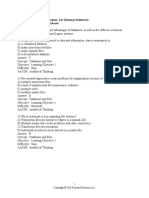Programming 1SQL Server 2012 PDF
Uploaded by
Kesani Venkat Narsimha ReddyProgramming 1SQL Server 2012 PDF
Uploaded by
Kesani Venkat Narsimha ReddyMind Q Systems Private Limited
SQL SERVER 2012
INTRODUCTION
What is a Database?
Database Architectures
SQL Server 2012 Architecture
Editions of SQL Server 2012
Installing SQL Server 2012
Tools and utilities in SQL Server 2012
CREATING AND
MANAGING DATABASES
Data Storage
System Databases
Creating User-defined Databases
Working with Databases
Case Study: creating an Inventory
Database
SQL-The Structured Query
Language
WORKING WITH TABLES
Types of Tables
Creating and Using tables
Creating and using Partitioned Tables
RETRIEVING DATA
SELECT Statement
FROM and WHERE Clauses
Using GROUP BY Clause
Using HAVING Clause
ORDER BY Clause
Creating a Copy Table
DATA INTEGRITY
What is Data Integrity?
Types of Integrity Constraints
Enabling and Disabling Constraints
Rules and Defaults
Case Study: creating tables with
data integrity in Inventory
Database
JOINS
What is a Join?
Types of Joins
Alternate syntax for joins
Complex Joins
BUILT-IN FUNCTIONS
Aggregate Functions
Numeric Functions
Date and Time Functions
String Functions
CAST and CONVERT
RETRIEVING DATA
ADVANCED
What is a sub query?
Types of Sub Queries
Working with CORRELATED
SUBQUERIES
Working with CTEs
Operators
LIKE, IN, ANY, BETWEEN, EXIST
Case Study: Querying Inventory
Database
Mind Q Systems Pvt Ltd
Ph: +91.40.66 66 42 91 / 92
Email: info@mindqsystems.com; Url: www.mindqsystems.com; : www.facebook.com/mindqsystems
Mind Q Systems Private Limited
VIEWS
What is a View?
Creating and using Views
Materialized Views
NORMALIZATION
What is Normalization?
Normal Forms
Advantages and Disadvantages
Denormalization
T-SQL PROGRAMMING
INTRODUCTION
Fundamentals
Control-of-flow Language Statements
Scripts and Batches
CURSORS
What is a Cursor?
Types of Cursors
Statements in the usage of a Cursor
@@FETCH_STATUS
TRANSACTIONS
ACID Properties
Types of Transactions
COMMIT, ROLLBACK, SAVE
STORED PROCEDURES
Definition
Types of Stored Procedures
Creating a Stored Procedure
Input and Output Parameters
Executing a Stored Procedure
Error Handling in Stored Procedures
Debugging a Stored Procedure
TRIGGERS
Definition
Creating a Trigger
Types of Triggers
DDL Triggers
DML Triggers
INSTEAD OF Triggers
Setting Triggering Order
USER-DEFINED
FUNCTIONS
What is a UDF?
Creating and using UDFs
UDFs returning a table
SECURITY
Security Basics
Authentication Modes
Creating a login
Providing permissions on a database
Providing permissions on database
objects
PERFORMANCE TUNING
Tuning Queries
When to Tune?
Strategies in Tuning
Evaluating Query Performance
Tuning Query Performance
Finding out which queries to Tune
Working with Indexes
Index Uses
Types of Indexes
Creating Indexes
Index Fragmentation
Tuning Indexes
Mind Q Systems Pvt Ltd
Ph: +91.40.66 66 42 91 / 92
Email: info@mindqsystems.com; Url: www.mindqsystems.com; : www.facebook.com/mindqsystems
Mind Q Systems Private Limited
XML INTEGRATION
XML Datatype
Using XML Schema collections
Retrieve Related Data as XML
Transform XML data into Relational
Data
Query XML Data
Manage XML Data
EXTENDING SQL SERVER
FUNCTIONALITIES
Using SQLCLR and FileStreams
Implementing Spacial Datatypes
Implementing FullText Search
Implementing Service Broker Solutions
Distributed Queries
Backup & Restoring Databases
NEW FEATURES IN SQL
SERVER 2012
Sequences
Enhanced Exception Handling in stored
procedures
Introduction to Data Quality
Services(DQS)
INTERVIEW BASED FAQs
Certification Orientation
Mind Q Systems Pvt Ltd
Ph: +91.40.66 66 42 91 / 92
Email: info@mindqsystems.com; Url: www.mindqsystems.com; : www.facebook.com/mindqsystems
You might also like
- Murach's SQL Server 2019 For Developers Isbn139781943872572100% (2)Murach's SQL Server 2019 For Developers Isbn139781943872572700 pages
- Murachs SQL Server 2016 For Developers - Searchable PDF70% (10)Murachs SQL Server 2016 For Developers - Searchable PDF696 pages
- IS 4420 Database Fundamentals Introduction To SQL Leon ChenNo ratings yetIS 4420 Database Fundamentals Introduction To SQL Leon Chen42 pages
- IS 4420 Database Fundamentals Introduction To SQL Leon ChenNo ratings yetIS 4420 Database Fundamentals Introduction To SQL Leon Chen42 pages
- IS 4420 Database Fundamentals Introduction To SQL Leon ChenNo ratings yetIS 4420 Database Fundamentals Introduction To SQL Leon Chen42 pages
- SQL Server 2012 - MCSA - MCSE Study PlanNo ratings yetSQL Server 2012 - MCSA - MCSE Study Plan30 pages
- Introduction To Structured Query Language (SQL)No ratings yetIntroduction To Structured Query Language (SQL)55 pages
- 15 Conceptual SQL Interview Questions and Answers - by John H. - MediumNo ratings yet15 Conceptual SQL Interview Questions and Answers - by John H. - Medium9 pages
- CH 5. Structured Query Language (SQL) PDFNo ratings yetCH 5. Structured Query Language (SQL) PDF41 pages
- SQL Developer and SQL DBA Training Masters ProgramNo ratings yetSQL Developer and SQL DBA Training Masters Program10 pages
- Module 1: Getting Started With Databases and Transact-SQL in SQL Server 2008No ratings yetModule 1: Getting Started With Databases and Transact-SQL in SQL Server 200837 pages
- Dec8866f 18e8 4bf7 Af90 3a2163dc8926 66ceccbbf19c36001a612c86 1724828893 Introduction to Structured Query Language SQL 1No ratings yetDec8866f 18e8 4bf7 Af90 3a2163dc8926 66ceccbbf19c36001a612c86 1724828893 Introduction to Structured Query Language SQL 160 pages
- 70 461 Exam Guide Querying Microsoft SQL Server 2012 PDFNo ratings yet70 461 Exam Guide Querying Microsoft SQL Server 2012 PDF10 pages
- Module 1: Getting Started With Databases and Transact-SQL in SQL Server 2008No ratings yetModule 1: Getting Started With Databases and Transact-SQL in SQL Server 200837 pages
- Lecture 01 - Quiz 01 - Midterm - Advdbmgmt - ElmsNo ratings yetLecture 01 - Quiz 01 - Midterm - Advdbmgmt - Elms26 pages
- Create: Create, Alter, Truncate, Drop Rename Grant Revoke Select, Insert, Delete UpdateNo ratings yetCreate: Create, Alter, Truncate, Drop Rename Grant Revoke Select, Insert, Delete Update11 pages
- MIV Fields Field Description Length Data Type Provide by PLT in SeqNo ratings yetMIV Fields Field Description Length Data Type Provide by PLT in Seq4 pages
- Set-Up Webmethods Terracotta Clustering PDFNo ratings yetSet-Up Webmethods Terracotta Clustering PDF13 pages
- SAP Exchange Infrastructure - WebMethods Integration PDFNo ratings yetSAP Exchange Infrastructure - WebMethods Integration PDF26 pages
- Vim Hands-On Tutorial: Computer Science DepartmentNo ratings yetVim Hands-On Tutorial: Computer Science Department17 pages
- Design of CMOS Analog Integrated Circuits: Franco MalobertiNo ratings yetDesign of CMOS Analog Integrated Circuits: Franco Maloberti25 pages
- ch4 Notes (Security Part II-Auditing Database Systems)No ratings yetch4 Notes (Security Part II-Auditing Database Systems)3 pages
- SAP Archiving Process-Simple Steps: ApplicationNo ratings yetSAP Archiving Process-Simple Steps: Application23 pages
- Recovery - Magisk 25.2 (25200) .Apk - 2022 10 31 20 49 07No ratings yetRecovery - Magisk 25.2 (25200) .Apk - 2022 10 31 20 49 0721 pages
- ALTO Disk Archive and Content Library Brochure - Doc Ref 281011-7 PDFNo ratings yetALTO Disk Archive and Content Library Brochure - Doc Ref 281011-7 PDF2 pages
- Hcit End of Cluster Test Databasae PracticalNo ratings yetHcit End of Cluster Test Databasae Practical4 pages
- What Are The Best Mapping Development Practices and What Are The Different Mapping Design Tips For Informatica?No ratings yetWhat Are The Best Mapping Development Practices and What Are The Different Mapping Design Tips For Informatica?29 pages
- Accounting Information Systems 14e Romney Chapter 4100% (1)Accounting Information Systems 14e Romney Chapter 440 pages
- ER Diagram Examples For Online Shopping SystemsNo ratings yetER Diagram Examples For Online Shopping Systems8 pages











